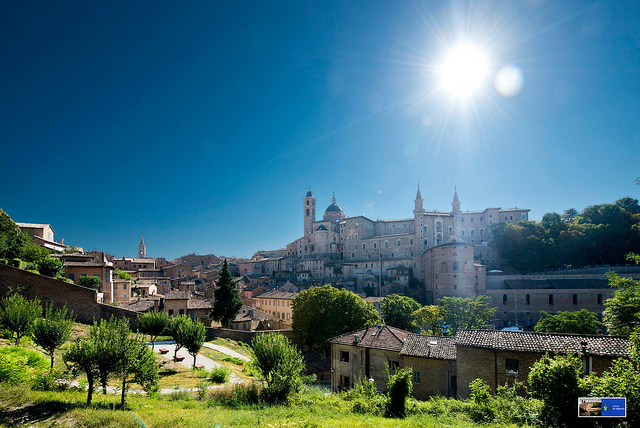Urbino is not on the radar of most tourists, which is what makes this magical city one of Italy’s best treasures. When you tire of the crowds in Rome and the tourist menus in Venice, head east for an authentic slice of Italy.

Photo: Turismo Marche via Flickr
Italy is one of those countries that slips with ease onto a bucket list. Rome, Venice and Florence pull in the sightseers. Cinque Terre has the hikers. Pompeii grabs at the historians. Amalfi and Rimini claim the sun-worshippers. And the entire boot-shaped country lures in the food lovers. Whatever you want, Italy has it in spades.
Yet, there is a side to Italy that often gets overlooked. In the rush to secure a picture of you pushing the leaning tower of Pisa back into place; staring wistfully as you glide along the Grand Canal or glowing after a the traipse to the top of Florence’s Duomo, many tourists who visit Italy forget to stop and seek out authentic Italian life.
Of course, the day to day running of the country’s most iconic cities is imbued with Italian reality. Pizzas are churned out, patios decked and a long glass of spritz is served in time for sunset. But in some ways, it is a tourist focused show, performed daily for the joy of the crowds.
Strip away the masses of visitors, travel around 200 miles south of Venice to the small city of Urbino, and a different side of Italian life unfolds.
Urbino lies in the Marche Region. It’s a city that is no stranger to tourism yet sits well out of the spotlight of its more famous sister cities – and is all the more authentic for it. Absent the trussed up gladiators that adorn the Colosseum in Rome and the multi-region menus that trick you into thinking lasagna is an Italian-wide specialty, Urbino offers an intense hit of real Italian life.
Urbino’s Arty Past, Present and Future
A university city at heart, Urbino pulses with cafes and bars. Visit at lunchtime and you’ll find crescia, a cross between a flatbread and pastry that is stuffed with meats and vegetables, being consumed almost as rapidly as the locals inhale espresso. The food here is regional, seasonal and Italian through and through, but it is the students dashing between art classes that bring the hilly streets to life (Urbino is one of the few places in Italy where the craft of Renaissance art restoration is taught to future generations).
For visitors, the pace can be slower. The imposing Ducal Palace is one of the first sights to greet you as you enter the walled city. Constructed in the 15th century for Duke Federico III da Montefeltro, parts of the palace had, at one point, fallen into ruin. However, after extensive effort and a not insignificant amount of restorative love and care, the palace has been returned to a state that simply commands you stop and stare. From ground to sky, crease your neck and trace the lines of the symmetrical two towers to their turreted top.
Inside the palace sits the National Gallery of Marche, home to some of the region’s and, indeed Italy’s, most significant Renaissance pieces. Most famous is Raphael’s Portrait of a Young Woman, often known as La Muta. Painted by the artist between 1507-1508, Raphael’s portrait is frequently compared to Leonardo Da Vinci’s Mona Lisa, and unsurprisingly is one of the most visited pieces in Urbino’s armoury of impressive art.
Raphael was born in Urbino and his presence still lingers subtly within the city, from the discrete fascia of the house where he lived to the simple statue that stands in his honour. However, as strong as Urbino’s ties are to it’s art history, the city does not rest in its past. This is evidenced most vibrantly in the Academy of Fine Arts which presents a fascinating, contemporary contrast to the Renaissance feel that otherwise prevails throughout the city.
Urbino’s Natural Wonders
While the palace, piazzas, grand cathedral and art are some of Urbino’s highlights, the best of what the city has to offer can be found by tucking away your map, discarding your bearings and wandering Urbino’s ancient streets. The city is crafted on top of undulating hillsides that roll thought the region.
Negotiate the ceaseless cobbles underfoot, endure a steep stint uphill and take a curve around any bend and Urbino is likely to present you with the most pleasant surprise – panoramas of red-tiled rooftops giving way to vivid green pastures. The vision may tick every box on the stereotypical Italian countryside list, but the lack of tourist touts and postcard sellers reinforce that you’re getting the real deal.
Task your memory and wind your way back to Urbino’s heart where the sounds of a pre-dinner spritz may call. As the piazzas fill with life, find a seat where you can sit and sip, elbow to elbow with students, residents and the small number of tourists alike. Drink in the views, drink in the reality and revel in the rare essence of what Urbino holds – an authentic slice of Italian life.